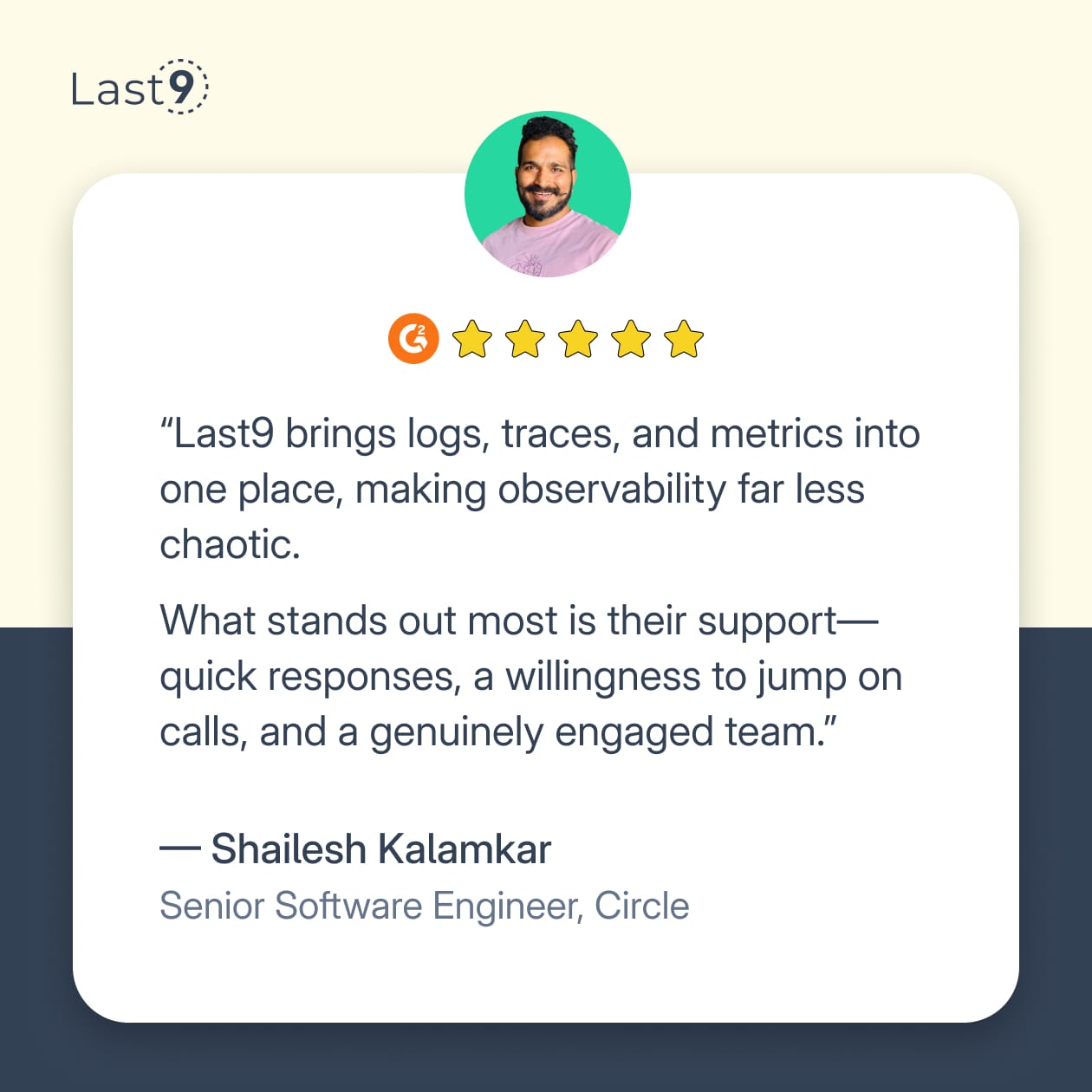As systems move to microservices, serverless, and multi-cloud setups, debugging gets harder. You’re no longer dealing with a single log file; you’re looking at logs from dozens of services, running across different environments.
Traditional debugging methods like SSH-ing into servers or adding print statements don’t scale in these environments.
Cloud log management tools help by collecting logs from all your services into one place. This makes it easier to trace issues, monitor system behavior, and understand what’s going on, without jumping between tools or writing ad-hoc scripts to grep logs.
What is Cloud Log Management?
Cloud log management means collecting, storing, and analyzing logs from your applications and infrastructure running in the cloud.
Unlike traditional setups where you manage your log servers, cloud-based tools handle the heavy lifting, auto-scaling, storage, indexing, and search, so you don’t have to worry about infrastructure or complex configurations.
Why Log Management Matters on AWS
If you’re building on AWS, you're likely using a mix of EC2, Lambda, ECS, RDS, and maybe a few more. Each of these services generates logs in different formats and locations. Without a way to bring those logs together, debugging turns into guesswork.
Centralized log management gives you a single view across your stack, so whether the issue is in your app code or the network layer, you can trace it without jumping through hoops.
What You Get:
- Troubleshooting: Search logs across all services from one place. No SSH. No hunting. Just query and find the issue.
- Real-time visibility: Logs stream in as they’re generated. That means you can spot problems right away, before users do.
- Built to scale: As traffic grows, the system scales with it. You don’t need to tune buffers or resize storage, it just works.
Log Management vs. SIEM: What’s the Difference?
Both log management and SIEM process logs, but they’re built for different goals.
- Log management is about running and debugging applications. It helps you understand how your system behaves, where things break, and how to fix them.
- SIEM (Security Information and Event Management) is focused on security, detecting threats, tracking unusual activity, and meeting compliance requirements.
What Log Management Tools Are Good At
Log management tools help you:
- Debug issues by correlating logs across services and containers
- Monitor performance and spot latency or error spikes
- Track custom events and key business metrics (e.g., signups, failed payments)
- Analyze usage patterns and error trends
- Automate alerts or scripts based on log patterns (e.g., restart a service when it crashes)
What SIEM Tools Handle
SIEM systems are designed for:
- Catching unauthorized logins or privilege escalations
- Detecting unusual patterns across user sessions, IPs, or regions
- Creating audit trails for compliance (e.g., PCI, HIPAA)
- Correlating security data from firewalls, IAM logs, and endpoint tools
- Sending alerts for potential threats or policy violations
Most teams start with log management to support development and ops. As security needs grow, SIEM comes into the picture, often as a separate layer or tool.
Cloud Monitoring vs. Cloud Logging
Cloud monitoring tracks numeric data over time, metrics like CPU load, memory usage, request latency, and error rates. It’s great for spotting trends and understanding how your system is behaving at a high level. These metrics are usually stored in a time-series database and updated at regular intervals.
Cloud logging, on the other hand, captures event-based data, discrete things that happened in your systems or applications. Consider process crashes, failed API calls, auth errors, or user signups. Each log is a point-in-time event with detailed context.
Cloud Logs vs. Application Logs
Cloud logging covers everything in your infrastructure: system-level logs, network logs, VPC flow logs, security events, etc.
Application logs are a subset of that. They’re generated by your code, like route handlers, background jobs, or middleware, and include details like:
- Which user triggered an action
- What the request payload looked like
- Which DB query took too long
- Why did a function throw an exception
Why Logs Matter for Performance Optimization
Monitoring can tell you something is wrong, maybe the p95 response time jumped. But it can’t tell you why.
Logs fill that gap. They give you the what, where, and under what conditions. For example:
- Which route was slow?
- What query was running?
- Did the cache miss?
- Was a downstream service failing?
This level of detail is what helps you debug slowdowns and improve performance faster.
Cloud Logging vs. Cloud Tracing
Cloud logging captures events from your applications and infrastructure. Each log entry is timestamped and contains context, like request IDs, user info, error messages, or transaction details. These logs help you see what happened at a specific moment.
Logging vs. Tracing: What’s the Difference?
- Logging captures isolated events; each entry stands alone. It’s useful for spotting errors, warnings, and application-level events.
- Tracing follows a request as it moves across services. It maps out the full path, from the frontend to the DB to downstream APIs, along with how long each step took.
Consider logs as individual snapshots, and traces as a timeline of connected actions.
When to Use What
Say a user reports that checkout is slow.
- Logs will show you what happened: login succeeded, cart updated, payment call returned a 502.
- Traces will show you how long each step took, where the slowdown happened, and how services interacted along the way.
For root cause analysis, you usually need both: logs for context, traces for flow, and timing.
What to Look for in a Cloud Log Management Solution
A good cloud log management system does three things well: gets logs in reliably, makes them easy to work with, and keeps them around for as long as you need, without burning a hole in your budget.
Ingestion, Aggregation, Retention
- Ingestion: You’re likely collecting logs from containers, functions, managed services, and maybe some legacy systems. The platform should handle high log volumes without dropping data and support common formats like JSON, syslog, or plain text.
- Aggregation: Once logs are in, you need to stitch them together. That means grouping logs by request ID, trace ID, or session so you can follow a user action or system event across multiple services.
- Retention: Not all logs are equal. Debug logs might be useful for a few days; audit logs might need to stick around for years. Choose a system that lets you set different retention policies per log type.
What the Major Providers Offer
- AWS:
- CloudWatch Logs integrates well with Lambda, ECS, and EC2.
- CloudTrail tracks API calls across your AWS account—useful for auditing and security.
- Google Cloud:
- Cloud Logging ties into the rest of GCP and supports log-based metrics, alerting, and BigQuery for advanced queries.
- Azure:
- Monitor Logs provides end-to-end logging for Azure services, queried using KQL (Kusto Query Language).
- Open Source:
- ELK Stack (Elasticsearch, Logstash, Kibana) gives you full control, but it takes effort to manage.
- Fluentd is a flexible log forwarder with strong plugin support.
- Grafana Loki is optimized for Kubernetes setups and keeps costs down by indexing only metadata.
Built-in Security and Alerting
Logs often contain sensitive information, so built-in security matters:
- Use role-based access control (RBAC) to limit who can query or view certain logs.
- Set up alerts based on log patterns, failed logins, repeated 500s, or custom error codes.
- Ensure logs are encrypted, both in transit and at rest.

Final Thoughts
If you're just getting started with logs, keep it basic: centralize them, make sure you can search fast, and set retention that fits how you work. That’s enough for early visibility.
As things scale, so do the problems: more log volume, harder trace correlation, slower debugging. That’s where Last9 helps. We pull together logs, metrics, and traces with native OpenTelemetry support, built for systems that need to scale.
You get:
- Real-time metrics via Streaming Aggregations, handle high cardinality without breaking the bank
- Easy deployment through AWS and GCP marketplaces
- Smart alerts and real-time insights that make sense to engineering teams
Get started with us today!
FAQs
What is log management in AWS?
Log management in AWS refers to collecting, storing, and analyzing log data from AWS services and applications using tools like CloudWatch Logs, CloudTrail, and AWS Config. AWS log management provides centralized visibility across EC2 instances, Lambda functions, RDS databases, and other AWS resources. It includes automatic log collection from many AWS services, configurable retention policies, and integration with other AWS monitoring tools.
What is the difference between SIEM and log management?
SIEM (Security Information and Event Management) focuses on security monitoring and threat detection, while log management concentrates on operational insights and troubleshooting. Log management helps developers debug applications and monitor performance, while SIEM correlates security events across systems to identify threats and maintain compliance. Most teams start with log management for operational needs and add SIEM capabilities as security requirements grow.
What is the difference between cloud monitoring and cloud logging?
Cloud monitoring tracks numerical metrics like CPU usage, memory consumption, and response times over time. Cloud logging captures event-based data from applications and infrastructure, including detailed contextual information about what happened, when, and why. Monitoring shows performance trends, while logging provides the detailed context needed for troubleshooting and understanding application behavior.
What is the difference between cloud logging and cloud tracing?
Cloud logging records discrete events that occur within applications and infrastructure - each log entry represents a single point in time. Cloud tracing follows requests as they move through distributed systems, showing the complete journey of a user action across multiple services. Logging provides the "what happened," while tracing shows the "how it happened" by revealing timing and dependencies between service calls.
What Is Cloud Log Management?
Cloud log management is the practice of collecting, storing, and analyzing log data from applications and infrastructure running in cloud environments. It provides automatic scaling, managed storage, and integrated analysis capabilities without requiring developers to maintain physical servers. Cloud log management offers centralized visibility across distributed systems with real-time processing and powerful query capabilities.
What do you use for a log aggregator?
Popular log aggregators include AWS CloudWatch Logs for AWS environments, Google Cloud Logging for GCP, and Azure Monitor Logs for Azure. Open source options include Fluentd, Logstash (part of ELK Stack), and Grafana Loki. The choice depends on your cloud provider, existing infrastructure, and specific requirements for log processing and analysis.
What are the strengths and limitations of open-source log management solutions?
Strengths: Open source solutions like ELK Stack offer complete customization, no vendor lock-in, and cost control. They provide flexibility to modify components and integrate with existing tools. Community support and extensive documentation make them accessible to many teams.
Limitations: Open source solutions require significant setup and maintenance effort. Teams need expertise in managing infrastructure, scaling, and troubleshooting. Hidden costs include server resources, maintenance time, and skilled personnel. They may lack some advanced features available in managed solutions.
Why is a log management tool important?
Log management tools are crucial for modern application development because they provide centralized visibility across distributed systems. They reduce troubleshooting time by allowing developers to search across all services from a single interface. These tools help identify performance bottlenecks, monitor user behavior, track business metrics, and automate responses to specific patterns. Without proper log management, debugging complex applications becomes nearly impossible.
Why use Grafana Cloud for log monitoring?
Grafana Cloud provides unified observability, combining logs, metrics, and traces in a single platform. It offers cost-effective pricing with usage-based billing, easy integration with existing Grafana dashboards, and powerful query capabilities through LogQL. Grafana Cloud eliminates infrastructure management overhead while providing enterprise-grade features like alerting, annotations, and team collaboration tools.
What Cloud Logging Service Will You Use?
The choice depends on your cloud provider and specific requirements. AWS CloudWatch Logs works best for AWS-centric environments with deep service integration. Google Cloud Logging offers advanced machine learning capabilities and BigQuery integration. Azure Monitor Logs provides comprehensive Azure ecosystem support. For multi-cloud environments, consider solutions like Grafana Cloud, Last9, or Datadog that work across providers.
How can cloud log management enhance security and compliance?
Cloud log management supports security and compliance through centralized audit trails, automated security monitoring, and retention policies that meet regulatory requirements. It enables real-time detection of suspicious activities, maintains tamper-proof log storage, and provides detailed access logs for compliance reporting. Role-based access control protects sensitive log data while encryption ensures data security throughout its lifecycle.
How do I choose the best cloud log management solution for my business?
Consider these factors when selecting a cloud log management solution: your primary cloud provider and existing infrastructure, expected log volume and retention requirements, budget constraints and pricing models, team expertise and maintenance capabilities, integration needs with existing tools, and specific compliance requirements. Start with basic log collection needs and choose solutions that can scale with your business growth.



